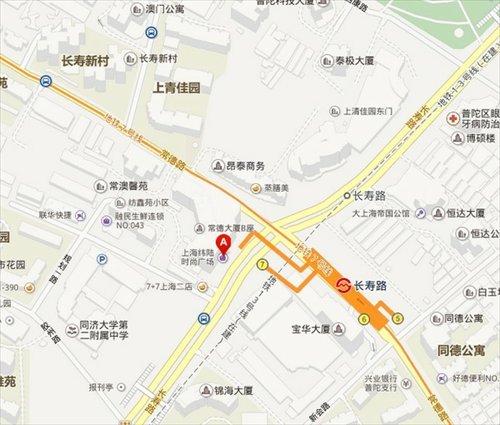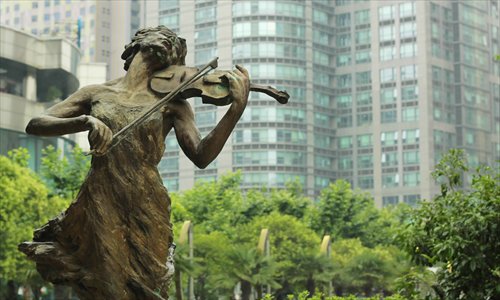Model of renewal
Editor's note
This year is the 21st anniversary of the opening of the Shanghai metro. The subway has facilitated more than 13 billion journeys during its 21 years, and half of Shanghai citizens cite the metro as their favored mode of transport. To commemorate the anniversary, each week the Global Times will take an in-depth look at one metro station and its surroundings. In the case of downtown stations, we will focus on points of interest within walking distance; while for suburban areas, we will cast our net a little wider.
Changshou Road Station on metro Line 7 is home to a flourishing subcenter that spans the city's Putuo and Jing'an districts. The Changshou Xincun neighborhood used to be one of the largest shantytowns in pre-1949 Shanghai, rife with notorious hooligans and filthy lowlifes.
Local residents' living conditions weren't radically improved until the 1980s, when the city government worked out a blueprint for the entire area to be remodelled as a modern, well-rounded residential community. After a solid decade of construction, Changshou Xincun now features lush greenery, accessible facilities and a far more pleasant environment.
The Global Times recently hopped on a Line 7 train and stopped at Changshou Road Station to explore the bustling commercial zone and the quieter surrounding areas.

Map
Yaxin Square
Emerging from the station's exit 5, you can't miss Shanghai Yaxin Square (401 Changshou Road, 6277-8888). It is a sprawling, community-based complex that offers a slew of dining, drinking, shopping and outing options.
Covering a total area of 19,000 square meters, Yaxin Square opened in late 1996. The complex is made up of six buildings with over a hundred brands and tenants.
This one-stop lifestyle destination not only meets the various needs of nearby residents, but also caters to the city's younger demographic with assorted cultural and entertainment events, including public exhibitions, live performances, and celebrity appearances.
The atrium regularly hosts special sales of well-known brands from home and abroad, during which shoppers can expect discounts of up to 80 percent.
V6 Fashion Square
Standing on the opposite side of Yaxin Square is V6 Fashion Square (432 Changshou Road, 6277-2456), an unassuming two-story building that houses a large number of fashion boutiques and beauty salons.
Image-conscious customers will be happy with the various manicure and pedicure services provided by the brightly lit beauty salons.
A basic manicure session starts at around 50 yuan ($8.08), but can cost up to several hundred yuan, depending on the products and patterns applied. Some salons also offer discounts for first-time customers.
Closely packed on the second floor of the fashion square are small boutiques with affordable clothes, shoes, handbags, jewelry and other accessories.
Exploring the labyrinth-like shopping mall and haggling with shop owners is fun, though be aware that some of the shops allegedly source their products from the wholesale markets on Qipu Road, which is notorious for low-quality knock-offs. In short, buyer beware!
Changshou Park
A five-minute walk north from the station's exit 7 will take you to Changshou Park (260 Changshou Road, 5252-1386). Opened in 2001, the 400,000-square-meter park was among the city's first batch of large-scale public green spaces. It boasts over 100 varieties of trees and flowers, creating exuberant greenery all the year around.
Apart from a serene environment, the park also exudes a strong artistic ambience thanks to a renovation project in 2005 that transformed the original Changshou Park into a sculpture-themed park.
Some two dozen sculptures are scattered around the park, created by local and overseas artists, and covering a wide range of themes and materials.
The park is open daily from 6 am to 7:30 pm. Admission is free.

A sculpture inside Changshou Park

Huxi Mosque is one of the city's best-known mosques. Photos: Yang Zhenqi/GT
Huxi Mosque
Tucked away in a residential compound on a thoroughfare adjacent to Changshou Road is one of the city's best-known mosques, Huxi Mosque (No.3, Lane 1328 Changde Road, 6277-2076).
The origin of this mosque can be traced back to the beginning of the 20th century when Chinese Muslims, along with many other people from across the country, flocked to the booming city in search of a better life.
The Muslim community that established itself in the area first rented a small venue as a makeshift prayer hall.
Eventually, a mosque was built in 1922 at Yaoshui Lane that could accommodate about 200 worshippers. It moved to its current location on Changde Road in 1992 as part of the area's renovation plans.
It was the very first mosque to be rebuilt in Shanghai after the founding of the People's Republic of China in 1949. The mosque was renamed Huxi Mosque, literally meaning "West Shanghai Mosque."
The white minarets make the building easy to find, even from a distance. The wood-and-brick mosque covers a moderate area of 1,125 square meters and is fashioned in the modern Islamic architectural style with distinctive features, including domes and columns.
The centerpiece of the mosque is a two-story prayer hall. Standing on the west side and covered in exquisite carpets, the hall can hold several hundred people.
Worshippers congregate here every afternoon to pray, and the imam also regularly delivers sermons and lectures from the minbar inside the prayer hall.
Halal food such as beef and lamb can be bought at the entrance to the mosque.
There is also a Friday market where taqiyah-wearing vendors sell snacks ranging from lamb skewers and pancakes to dried fruits and nuts.
The mosque opens from 8 am to 7 pm daily. Entrance is free, although suitable clothing should be worn.